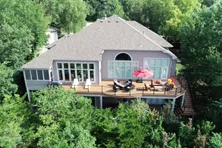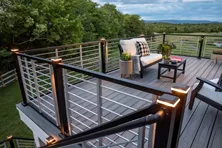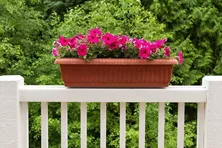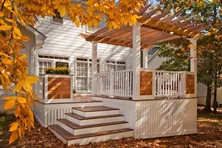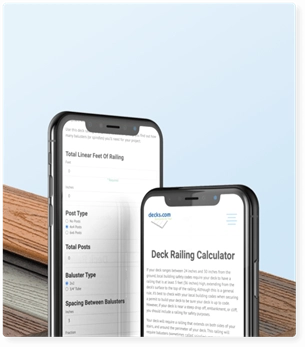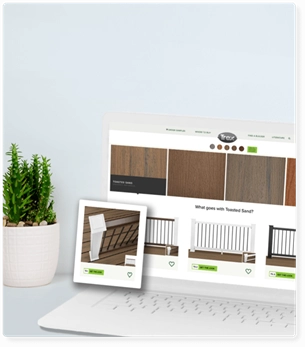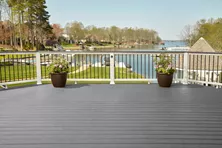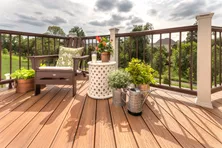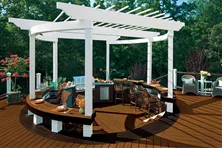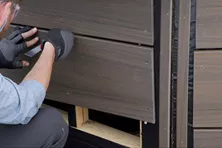Reddit’s Top 10 Deck Railing Questions Answered
Deck railing is an essential component of any deck, providing both safety and style. However, with so many materials, designs, and installation factors to consider, questions often arise. To help, our team of experts offers practical and insightful answers to 10 of the most frequently asked questions about deck railings found on Reddit.
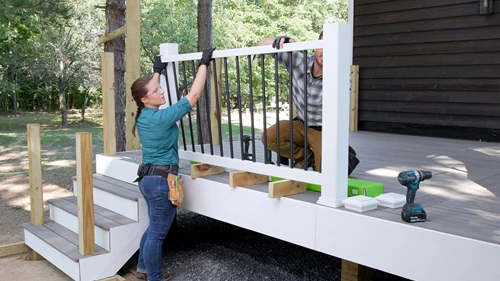
1. How Much Should I Expect To Pay for Railing?
Many homeowners experience sticker shock when they first price railings, often underestimating their share of the total project cost. Prices vary widely depending on the materials, deck size, and labor, but here are guidelines to give you an idea of what to expect:
Materials Cost Range for a 12 x 16-Ft. Deck* (Labor not included)
- Pressure-Treated Wood Railings:
- $15–$25 per linear ft.
- The least expensive option, but they require regular maintenance and may not last as long as other materials.
- For 56 linear ft.: $840–$1,400.
- Steel Railings:
- $20–$35 per linear ft.
- Offers the strength of aluminum at a budget-friendly price.
- For 56 linear ft.: $1,120–$1,960.
- PVC Railings:
- $25–$35 per linear ft.
- Low-maintenance and affordable.
- For 56 linear ft.: $1,400–$1,960.
- Composite Railings:
- $28–$65 per linear ft.
- Combines durability with low maintenance, making them a popular choice.
- For 56 linear ft.: $1,568–$3,640.
- Aluminum Railings:
- $35–$65 per linear ft.
- Includes options like Trex Select or Trex Signature.
- For 56 linear ft.: $1,960–$3,640.
- Specialty Railings (Cable Railing or Glass Railing):
- $80–$160 per linear ft.
- Sleek, modern, and premium in appearance.
- For 56 linear ft.: $4,480–$8,960.
* Cost reflect all required part to complete the railing like, posts, post sleeves, balusters, etc.
Labor Costs
Labor costs are usually 2/3 the total cost of your project. Here are some factors that will affect labor costs:
- Experience: Contractors with more experience and a good reputation might charge more, but this extra cost often means less headaches down the road.
- Material Type: Glass and cable railings require precision and may take more time to install than simpler options like wood or composite.
- Deck Height: Elevated decks might require scaffolding or additional safety measures, increasing labor costs.
- Customization: Curved railings or unique layouts will add to the labor expense.
- Location: Labor costs vary by region, with higher rates in metropolitan areas.
Ways To Save
For a 12 x 16-ft. deck, your total costs (labor and material) could range anywhere between $2,500 up to $16,000 or more. If these costs are beyond your budget, don’t despair—there are ways you may cut costs:
- Shop Around: Request quotes from multiple contractors to find the best deal. But remember that the lowest cost is not necessarily the best value. Make sure you get legitimate references from any contractor you are considering.
- Be Patient: Some contractors are willing to work at a discounted rate if they can use your deck railing as a fill-in project to complete when they encounter unexpected downtime. Wait to ask about this option after you receive their original quote.
DIY Installation: Using DIY-friendly railing systems, such as Trex Signature® Aluminum or Trex Enhance®, can significantly reduce costs.
2. How Do I Know if My Deck Railing Will be Safe?
Ensuring your railing meets safety and quality standards is crucial. Here are steps to ensure your deck railing will protect your friends and family for the life of your deck:
- Check Building Codes: This article, Understanding Standard Deck Railing Height Codes, clearly spells out what the building code height and spacing requirements are.
- Confirm Your Plans: Check with your local building official to ensure your railing is sturdy enough and meets your local building codes.
- Hire a Professional: Make sure your contract specifically states that all construction methods and materials meet local building code requirements.
- Follow Instructions: To ensure the safety and longevity of your new railing, and to maintain warranties, follow the manufacturer’s installation instructions.
Materials Matter: Use durable, low-maintenance materials like Trex for consistent performance.
3. Should I Add Railing to a Deck That Is Low to the Ground?
Building codes typically mandate a minimum railing height of 36 in. for decks higher than 30 in. off the ground, but your decision may involve more than just meeting code. Practical needs and aesthetic preferences often come into play when selecting your deck railing design. Here are a few factors to consider:
- Surface Below: Even a fall from short distances can cause an injury if the surface below is concrete or other hard material.
- Safety Concerns: Regardless of the deck’s height, railings are a valuable safety feature for households with young children, elderly family members, or individuals with mobility challenges.
- Privacy and Practicality: Higher railings or even enclosed walls can add privacy, block wind, or provide shade, making your deck more comfortable and functional.
- Aesthetics: Railings can elevate your deck’s visual appeal by serving as a showcase for planters or a spot to attach decorative lighting.
- Functional Enhancements: Having a surface to lean on or a drink rail to set a beverage on can elevate the function of your deck.
If you’re still brainstorming your deck design, check out this Deck AR Visualizer App. For guidance on constructing your railing, explore the helpful tutorials and videos available at Trex Academy.
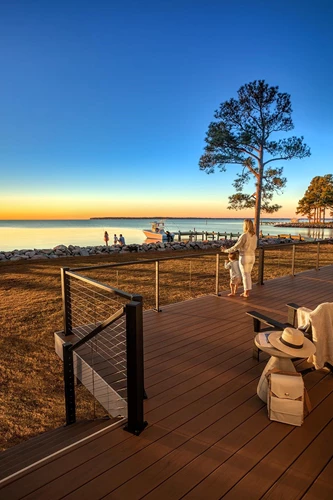
4. What Are the Pros/Cons of Wire Cable Railing?
Wire cable railings offer a modern, sleek aesthetic, but come with unique considerations.
- Pros:
- Minimal obstruction of views
- Low maintenance when properly installed
- Easy to install when using products like Trex Signature X-Series Kits
- Cons:
- Can be higher upfront costs
- Requires periodic tension checks
Horizontal cables pose potential safety concerns because small children may be tempted to climb them.
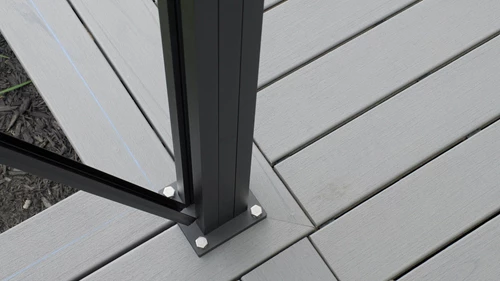
5. Are Surface-Mounted Deck Railing Posts Safe?
Yes, they are! However, building a sturdy frame and installing the proper blocking is key. Surface-mounted posts like Trex Signature® Posts have been engineered to be code compliant and are proven to be safe when installed correctly. This article on Trex Signature X-Series Cable Railing shows how surface-mounted posts should be installed.
6. Will I Regret Getting 42-in.-High Railings?
In many parts of the country, 36-in.-high railings are standard, but in many municipalities in states like California and Washington, 42 in. is the minimum height. Even if your local building codes require only 36-in. railings, increasing yours to 42 in. could keep a tall person from toppling or keep a child from climbing over the top of your railing. This extra peace of mind might be worth it if your deck is high off the ground. If your deck overlooks a beautiful vista, a 42-in. railing presents a larger visual obstruction, but choosing glass or cable-style railings can preserve the view. Here is some more information to help you choose a deck railing.
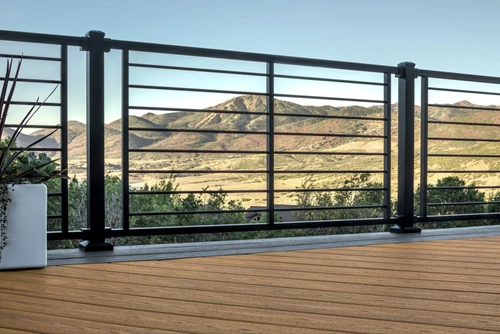
7. Will Horizontal Railings Pass Code?
Some building codes, especially earlier ones, expressed concerns about railings with horizontal rails, rather than vertical balusters. They were considered too "ladder-like" and easy for children to climb up and over. Most modern building codes no longer explicitly prohibit horizontal cables; however, some local municipalities and Homeowners Associations have added more stringent restrictions. Bottom line: Horizontal railings are code compliant in most of the United States, but it’s always best to check with your local building officials before committing to a particular railing configuration.
8. What Can I Do if the Bottom Railing Gap Is More Than 4 In.?
To prevent small children from getting stuck or sliding under the bottom rail of a deck railing, most codes require a maximum gap of 4 in. If your railing was built with a gap larger than that, and you are concerned about safety, here are some options:
- Install small balusters between the bottom rail and the decking. Just make sure the spacing between the new balusters is less than 4 in.
- If the space is just a bit more than 4 in., you could add a small trim board to the bottom of the bottom rail.
- You could add a sturdy but decorative element, like lattice or hog rail, between the bottom rail and the decking.
- Finally, you could replace your railing with a beautiful, easy-to-install Trex railing system.
9. How Do I Paint Deck Railing Without Getting Paint on the Deck Boards?
Painting railings requires careful preparation. Here are the basic steps:
- Wash the decking so that painter’s tape sticks to it.
- Install painter’s tape over the decking around posts and near walls.
- Tape 12-in. painter’s paper to that tape.
- Surround the painter’s paper with a drop cloth or tarp.
- Keep the paint area uncluttered, so you don’t accidentally trip and knock over a paint pail.
Never paint or stain railings on a windy day.
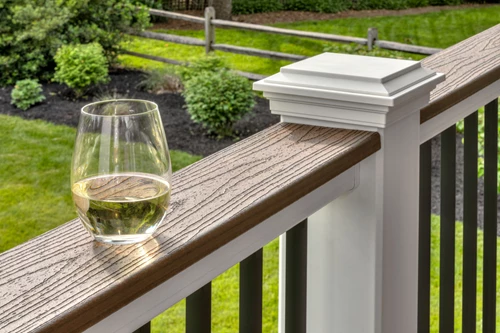
10. What Size Should the Top and Bottom Horizontal Boards Be?
The top and bottom boards on a deck railing are called rails. They are not required to be any particular size. On a standard deck railing, they must combine with the post and balusters to create a structure strong enough to meet the local building code structural mandates. The exception is when the top rail of a railing also serves as a handrail on stairs—building codes the regulate handrails have very specific requirements for their size and shape. Many deck owners choose to add a separate graspable handrail alongside the stair railings. When it comes to the top rail on standard deck railings, many owners choose to add planters or create a top rail that serves as a place to set a beverage.
More Deck Building Design Considerations
Feeling overwhelmed by the seemingly endless options for deck railings and your deck design? Don’t worry—we’ve got you covered. For the information you need to make those deck design decisions with confidence, check out this article on What to Consider When Building a Deck.
Glass Deck Railing Ideas and DIY Installation Tips
All glass panels used for deck railings must be safety-tempered and shatter-resistant. Learn how to install glass railing panels and get ideas for your deck.
How to Install Metal Deck Railings
Metal deck railings can add a sophisticated and modern look to your deck. Learn how to install metal and aluminum deck railings
Steps To Build & Secure A Deck Railing Planter
Railing planters are an easy way to add some color to your deck without taking up space. Follow these simple steps and get started on your railing planters today.
Deck Skirting
Skirting can be an attractive feature that can be added to any low-level deck.
Our Favorite Outdoor Deck Lighting Ideas
Brighten up your outdoor living space and learn how to incorporate lighting fixtures into your deck to enhance your entertainment area.
More Helpful Resources
Explore Articles by Topic

Footings
Information related to installing frost footings for decks
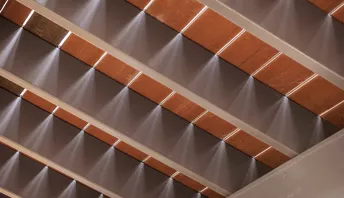
Framing
Learn structural framing methods
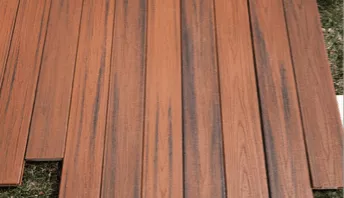
Decking
Learn about wood and composite decking materials
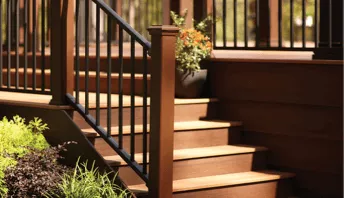
Stairs
An in-depth look at the complex issue of how to build stairs
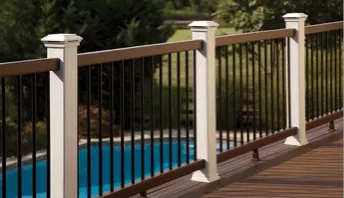
Railings
How to install guardrails and handrails to meet IRC code
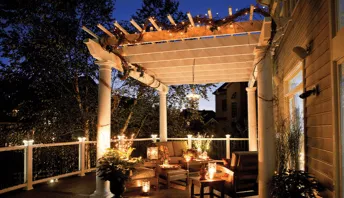
Features
An overview on water drainage, benches, planters and lights
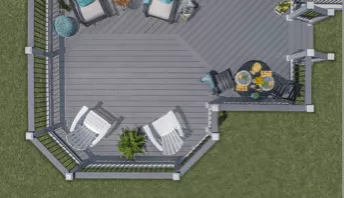
Design
The basics of deck design
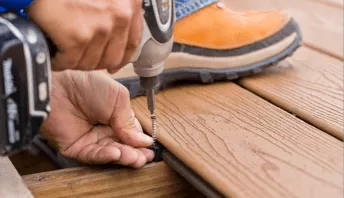
Planning
Learn about permits and working with contractors
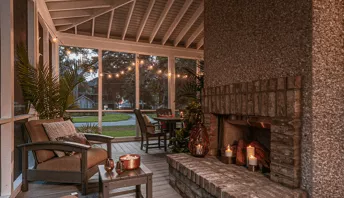
Porches & Patios
Build a covered deck to enjoy all seasons
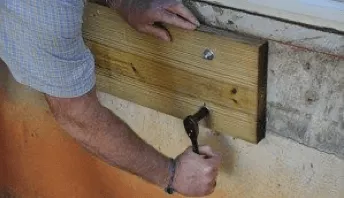
Ledger
Proper attachment techniques
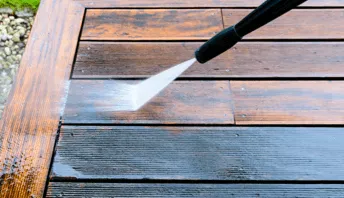
Care
Maintain your deck to maintain your investment
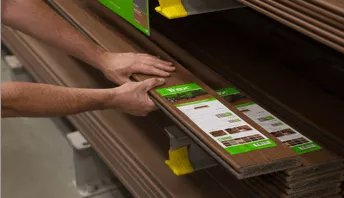
Materials
An overview on water drainage, benches, planters and lights
Steel vs Aluminum Deck Railings
Discover the key differences between steel and aluminum railings, including maintenance, durability, installation, and cost—perfect for homeowners and pros.
Deck Railing Height Requirements
Understanding deck railing height is important for meeting code requirements. Learn how high you should build your deck railing.
How to Choose the Right Deck Railing
As one of the most visible elements of a deck, railings add support, safety and style. Get tips for choosing the right deck railing at Decks.com.
5 Best Ways on How to Hide Trash Cans Outside
Outdoor trash cans can be an unwanted eyesore. Discover how you can easily cover them up and add an extra touch of beauty to your yard.
Building an Outdoor Kitchen? Here’s What You Should Consider Before You Start
Building an outdoor kitchen is an investment that can add value to your home. Learn what you should consider before building an outdoor kitchen on Decks.com.
Deck Skirting Ideas
Deck skirting offers more than aesthetics. From added storage to critter deterrence and concealing structures, explore our top ideas for your backyard's transformation.
Explore Articles by Topic

Footings
Information related to installing frost footings for decks

Framing
Learn structural framing methods

Decking
Learn about wood and composite decking materials

Stairs
An in-depth look at the complex issue of how to build stairs

Railings
How to install guardrails and handrails to meet IRC code

Features
An overview on water drainage, benches, planters and lights

Design
The basics of deck design

Planning
Learn about permits and working with contractors

Porches & Patios
Build a covered deck to enjoy all seasons

Ledger
Proper attachment techniques

Care
Maintain your deck to maintain your investment

Materials
An overview on water drainage, benches, planters and lights




